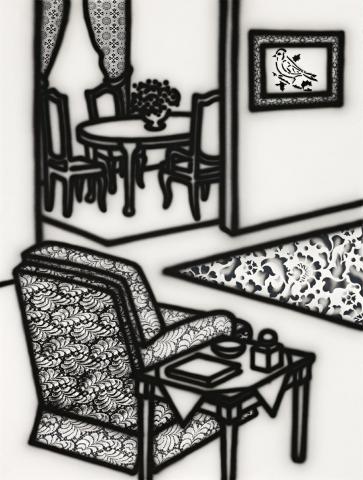LETTER-BOX HOME, 1995
HOWARD ARKLEY
synthetic polymer paint on paper
160.0 x 120.5 cm
signed, dated and inscribed with title verso: ... Howard Arkley / ... Letter-box Home / ... 1995 ...
Chris Deutscher, Melbourne, acquired directly from the artist c1992
Private collection, Melbourne
Suparoom, 1992, synthetic polymer paint on canvas, 173.0 x 135.0 cm, illus. in Crawford, A. and Edgar, R., Spray: The Work of Howard Arkley, Craftsman House, Sydney, 1995, p. 106
Room Within a Home, 1995, synthetic polymer paint on paper, 160.0 x 121.0 cm, Exhibited: Howard Arkley, Tolarno Galleries, Melbourne, September 1995, cat. 37, illus. in Arkley Works electronic catalogue raissoné: http://arkleyworks.com/?p=4500
Fabricated Rooms, 1999, synthetic polymer paint on 17 canvases, 203.0 x 1930.0 cm (overall), Corbett Lyon and Yueji Lyon Collection of Contemporary Australian Art, Melbourne, illus. in Crawford, A. and Edgar, R., Spray: The Work of Howard Arkley, (Revised Edition) Craftsman House, Sydney, 2001, fig. 130
In 1992, as we were preparing for the first Howard Arkley monograph to go to press, a somewhat impassioned discussion ensued - just what should grace the cover of the book? There was a plethora of options, but it soon came down to a debate between one of Arkley's now iconic suburban home exteriors or something, let us say, more intimate.
After much debate, it was intimacy that won the day. For all the wonders Arkley performed with the image of the suburban home, there was something remarkably potent about entering the home, being invited inside, perhaps, given the decor, for a soothing cup of tea? For without doubt we all recognised this interior, we all had or have older parents, grandparents or an auntie who did indeed live exactly here, complete with the stenciled bird picture on the wall and the flowers on the table.
Letter-Box Home, 1995 hails from an extraordinary period in Howard Arkley's career. During the early 1990s large scale works on paper became a passion for the artist. They were a medium with which to explore ideas and new techniques, one of which, seen amply in Letter-Box Home was the use of stencils. Arkley worked assiduously to both avoid repetition in his stenciling and to plot increasingly imaginative ways to 'design' his furnishings, rugs, curtains and other suburban paraphernalia. The intense variations, which recall the more hallucinogenic aspects of his visual language, shift from minimal, as seen on the rug, to the baroque of his lounge chair covering. These are in turn carefully contrasted by the carefully articulated voids of the walls, giving the picture its potent sense of three-dimensionality, allowing us to imagine we could walk into the frame.
As with many of his key motifs, Arkley would go on to further explore interiors. The structural approach taken with Letter-Box Home would culminate in a major component of The Home Show at the Venice Biennale in 1999. As part of the massive 17 panel Fabricated Rooms (1997-99), which he exhibited in Venice, he executed a lounge and dining setting that bears a distinct correlation with Letter-Box Home.
Again, it is the intimacy of the work that is so remarkably seductive with Letter-Box Home. A part of this is the simple fact that it is a work on paper and although large, most certainly of a scale that would suit most domestic spaces.
Letter-Box Home could be a scene snapped straight out of a 1950s Home Beautiful, the slightly retro aesthetic that the artist adored. Arkley would hoard old magazines and property flyers, delighting in the purpose-built perfection and the constructs surrounding the mythos of suburban life. Growing up in suburbia himself he knew this was largely a fiction, a romance far parted from the gritty day-to-day. Yet Arkley was never able to allow cynicism to rule the day. As tempting as it could be to read his work as a sarcastic critique of suburbia, this was neither his intention, nor the result. Letter-Box Home is, in fact, an illustration of a place he called home.
The title of the work may be a form of note-to-self - a reminder of another motif he was keen to explore. Arkley, amongst his bower-bird-like hoard, had contemplated the variations of suburban letter boxes as a potential springboard, in much the same way he had utilised suburban screen doors for early abstract works.
ASHLEY CRAWFORD
